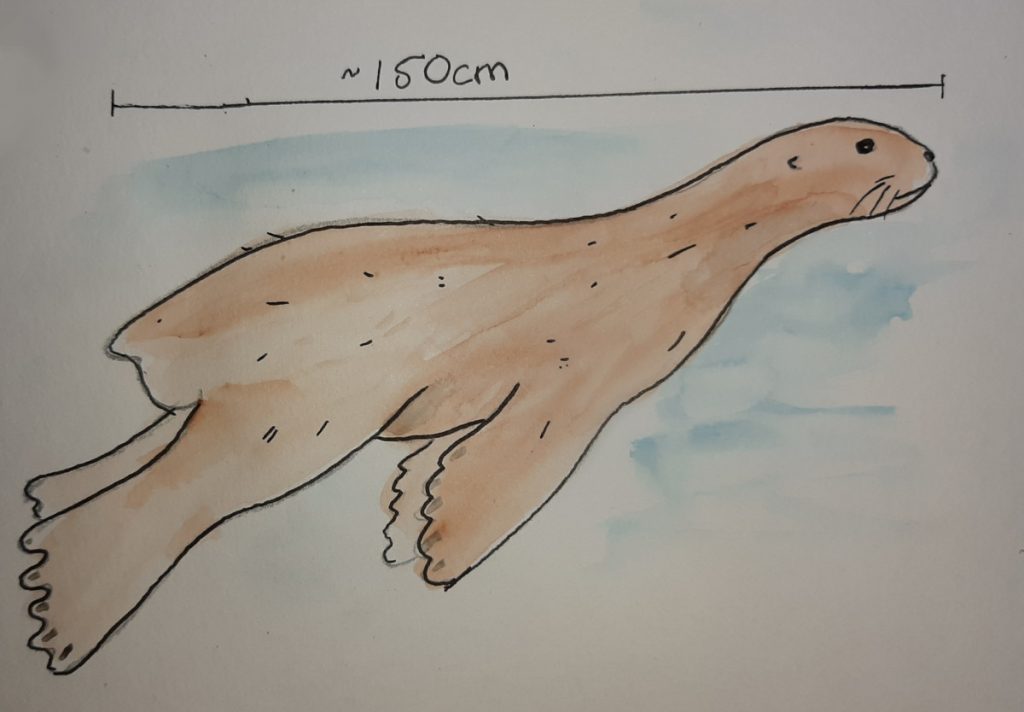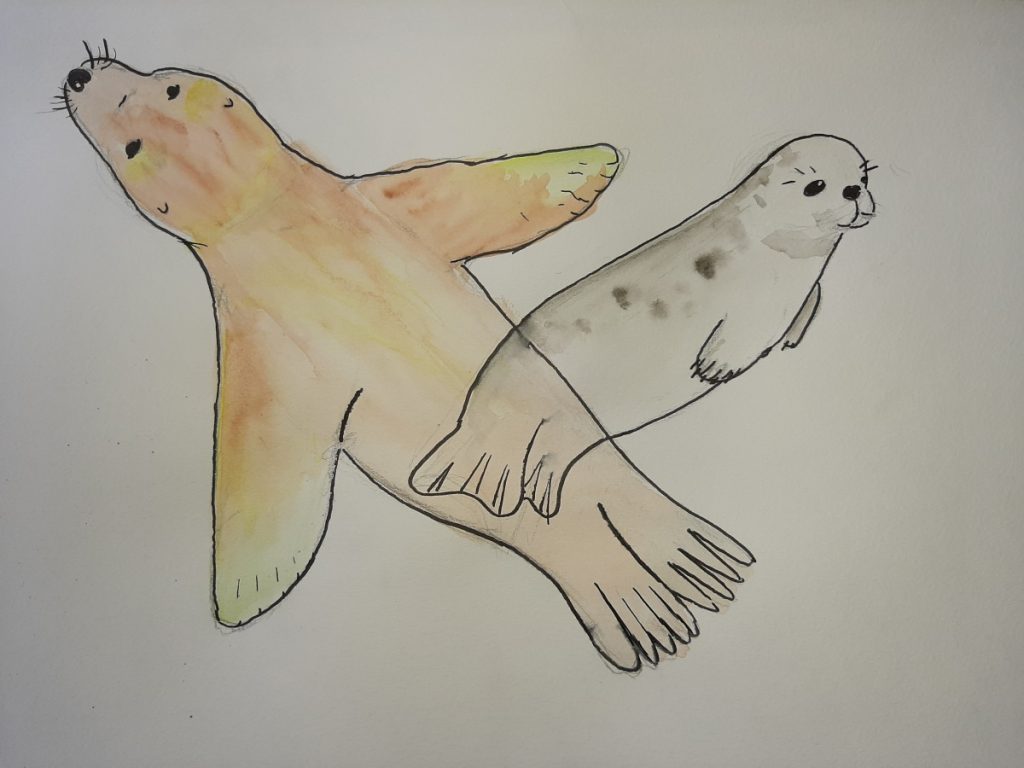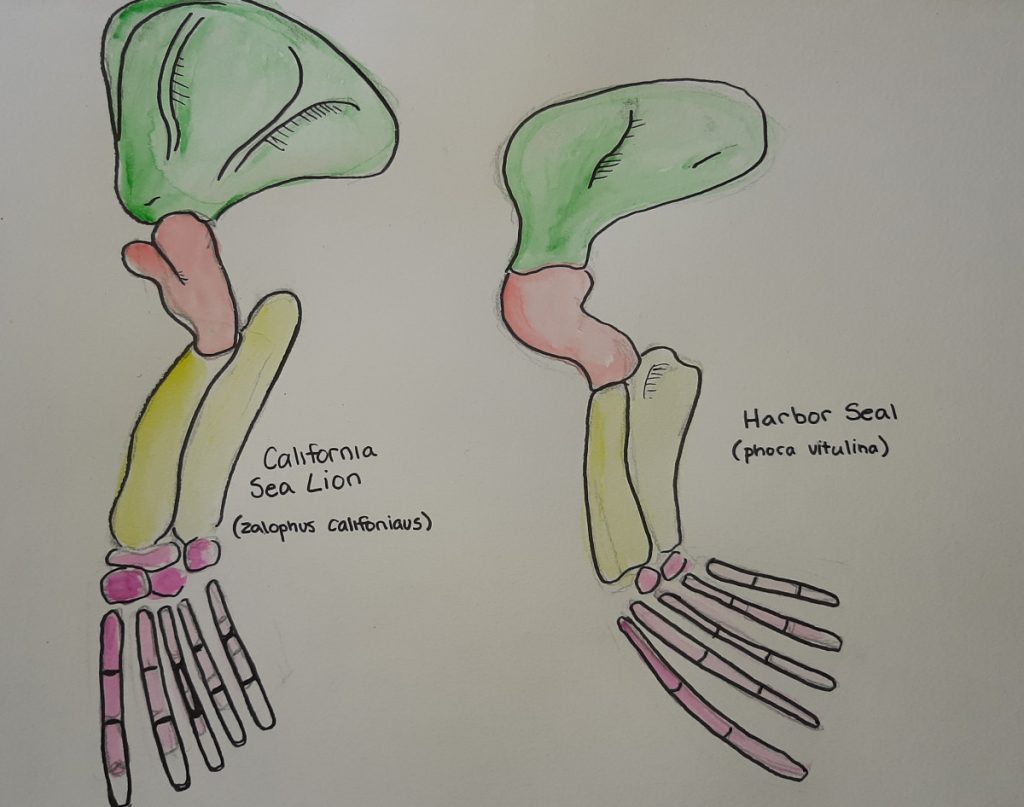Living in the pacific northwest it is not uncommon to see a Harbor Seal (phoca vitulina) or California Sea Lion (zalophus californiaus) at some point in a residents life. However, it is just as common for these two to be mistaken for one another in their natural habitat. These organisms live and thrive in our waters with very different lifestyles. One large way to clearly distinguish one from the other is to look inside the skeletal anatomy of the organisms, even looking as far back as their common ancestor.

While there is some debate regarding the common ancestor of the Otariid (eared seal) and Phocid (earless seal) family trees, it is most commonly agreed that the Enaliarctos mealsi is the farthest tracable common ancestor among these two species. When looking at the reconstructed skeleton of this organism it is clear to see that it has many similar characteristics between the two, but the proportions of the bones are varied. “At the elbow, the articular surfaces of the Enaliarctos are more similar to those of pinnipeds than of terrestrial carnivorans.”(Berta, Ray, 145) It is stated that their radius is short and heavy, and the neck is distinctly short compared to other pinnipeds, the pelvis is resemblant most species of pinnipeds with a small illium releatibe to the pubis, and the femur is short wide and flat. This primative version of the Harbor Seal and California Sea lion contain evidence both of evolution of the species and homologous structures between the two when later looking at the anatomy of its later relatives.

The california sea lion, a member of the Otarid family, is a species that focuses heavily on front fin motion to move through the water quickly to catch prey. “[Their flippers] are dorsoventrally compressed and hydrofoil-shaped” (Feldkamp, 133) reducing drag, and improving lift and propulsion, and also ”generate propulsive forces through lateral or vertical oscillations of their caudal appendages” (Lighthill, 1969). This style of swimming is available to the species due to its developed foreflippers compared to E. mealsi. The radius, ulna and humerous are all elongated and widened, with a highly developed scapula. This allows the muscles to strenghen along the arms therefore allowing propulsion.
Harbor Seals, a member of the Phociid family on the other hand, have foreflippers held against their bodies and are primarily used for steering, relying on their hindflippers. “The entire posterior portion of the body is swept to one side” (Paterson, 18) and then the other. This hind-body oscillation is the primary method of propulsion through the water. Compared to E. mealsi and the California Sea Lion the development of the foreflippers is not to get bigger and stronger, but to become short and compact in order to steer rather than propell. The hindlegs however have strenghened and the metatarsels/didgets have spread appart in order for webbing to encourage propulsion.

Due to these differences in motion observed in the California Sea Lion and the Harbor seal we can compare the structure of the bones to predict the movement of their ancestor. Due to compact proportions of its foreflippers, it is predicted that enaliarctos moved “with horizontal movements in the posterior end of the body” (Berta, Ray, 153). The rigidity and lack of development in this area suggests that enaliarctos moved more like a modern harbor seal. Further comparing to this organism, the short flat hind-limbs suggest that the tibia and fibula were hartier bones for propulsion.
Umwelt of a Harbor Seal:
I cannot be mistaken. The smell of prey catches my nose and I dive down from the rock I have spent the day basking on. Pushing my flippers against my side I dive down deeper and deeper. Yes. I can see it. My back fins make a hard swish to the right, left and go! My whiskers bend to my snout as I streamline toward my prey with an open mouth and my flippers fanning behind me. I am faster, or maybe smarter, than the fish that now is crushed between my teeth. Either way, I am victorious.
Umwelt of California Sea Lion:
It’s too fast. I’m too far away from land. The giant toothy creature behind me is gaining. My flippers are pushing through the water and my shoulders are beginning to burn but I have no other choice than to swim. The black creature with the white spots may be gaining, may have left but I do not turn around. Then I feel the crushing pain on my back fin. I swim, I bite, I flail with everything I have but it even my strength isn’t enough to beat this beast.
Bibliography
Berta, Annalisa, and Clayton E. Ray. “Skeletal Morphology and Locomotor Capabilities of the Archaic Pinniped Enaliarctos Mealsi.” Journal of Vertebrate Paleontology, vol. 10, no. 2, 1990, pp. 141–157. JSTOR, www.jstor.org/stable/4523311. Accessed 15 May 2020.
Feldkamp, Steven D. “Swimming in the California sea lion: morphometrics, drag and energetics.” Journal of Experimental Biology 131.1 (1987): 117-135.
Lighthill, M. J. (1969). Hydromechanics of aquatic animal propulsion. A. Rev. Fluid Mech. 1, 413-446.
Paterson, Ryan. “Evidence for the independent acquisition of aquatic specializations in pinnipeds (seals, sea lions, and walruses): insights from the study of the phylogenetic position, locomotor behaviour, and description of the stem pinniped, Puijila darwini.” (2017).

